"While the emissions from UK electricity production have decreased by over 40% relative to 1990 levels, electricity is only about 20% of total UK energy use, and progress in other sectors has been much slower. Its Energy White Paper, published last December, includes the prospect of three 'waves' of nuclear energy - gigawatt-sized nuclear, small modular pressurised water reactors and advanced modular reactors (AMRs). The paper also outlined a role for hydrogen as a fuel. AMRs offer new options for hydrogen production, but could equally be a costly distraction. The Dalton Nuclear Institute has explored these questions in a paper, Nuclear Energy for Net Zero: A Strategy for Action.
Nuclear hydrogen
Hydrogen is attractive for the decarbonisation of some energy sectors where electric power is unsuitable, and could have a large role in the decarbonisation of transport, industry and domestic heating. Electrolysis of water is commonly advocated but the better developed, low and medium temperature processes are inefficient and expensive, particularly if the primary electricity supply is being switched between supplying a distribution network when demand is high, and hydrogen production when there is an electricity surplus.
Although the light water reactor (LWR) technology of the first two waves is optimised for electricity production, advanced nuclear reactors, which can produce much higher outlet temperatures, offer the possibility of avoiding the inefficiencies of electricity generation and, instead, using the reactor heat to drive thermochemical decomposition of water directly, which is much more efficient than electrolysis in producing hydrogen. To develop this radical option, we need clear leadership and a strong focus on assessing the feasibility of these technologies, followed by rapid development if they do turn out to have a part to play.
The level playing field
It is thus essential that the roles for nuclear energy are set out and assessed clearly, acknowledging they will only be adopted as part of an optimised solution. It is also essential therefore, that similarly objective assessment mechanisms are applied to all decarbonisation options, using methodologies such as the Energy Systems Modelling Environment of the Energy Systems Catapult, which finds minimum cost solutions across the whole energy system. If the most economic nuclear system does not figure in the best overall programme, then nuclear energy has simply priced itself out of at least that part of the market.
Rigorous assessment of all aspects of decarbonisation is key to any realistic attempt at achieving net zero, necessitating a level playing field with sober analysis replacing 'point-scoring' between proponents of different technologies for the energy system. There are many examples of proposed systems which produce 'the right answer' in terms of electricity or hydrogen cost, but often offer little supporting evidence.
The range of opinions on nuclear energy is driven largely by differing value-sets, with a spectrum of views on the magnitude, likelihood and importance of a benefit or non-benefit. However, groups of stakeholders can, given time and expert mediation, reach agreement on the facts, while remaining at variance on the importance to be attributed to those facts. This does, however, require an open and peer-reviewed assessment of any system; be it the radiation doses from nuclear energy, the carbon intensity of carbon capture and storage, or the resource needs of batteries or solar PV. In this context, the influential Climate Change Committee envisages and has examined only a very limited role for nuclear. It would be helpful for such an important advisory body to undertake a wider examination.
Delivering
Time is critically short. If advanced nuclear is to play a part, then development needs to start now, to give enough time to demonstrate it for rapid deployment by the early 2030s. The very recent opening up of the UK regulatory assessment process to advanced nuclear technologies is a welcome first step.
The compressed timescale severely limits our choice of nuclear technology and we conclude that only the High Temperature Gas-cooled Reactor (HTGR) is a realistic option, not least because there is the possibility of international collaboration to speed things up. Delivering this requires consistent leadership and commitment comparable to that shown in the fusion arena by the UKAEA. The UK has several assets which it can use to deliver HTGR technology, notably in fuels and gas-cooled reactors but there are also major challenges in deploying HTGRs.
High operating temperatures stress the reactor materials so there is a tension between seeking ever higher temperatures and the design challenges, particularly in materials selection and performance. Beyond these technical issues, HTGRs will also be deployed in new ways, potentially close to towns and cities, or major industrial plants, or collocated with hydrogen production facilities. The societal and regulatory aspects of using nuclear energy in this way are likely to be some of the most difficult aspects of deployment.
The UK needs to move fast to resolve the question of whether or not it is willing to go forward with HTGRs and hydrogen, and if so, to take any opportunity which is there. If it continues to prevaricate, any opportunity will certainly be lost. Either way, the rest of the world will watch and learn from the UK's pioneering commitment to net zero - hopefully seeing the country as a template rather than as an example of missed opportunity."






_63865.jpg)
_18570.jpg)
_16159.jpg)



